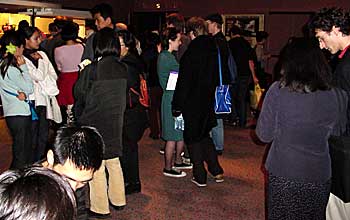
by Dan Barry
Launching October 19th, London's Barbican Arts Centre-a massive arts complex and home to the Royal Shakespeare Company-hosted an event that had United Kingdom anime fans coming out in droves. Studio Ghibli: The Art of Japanese Animation marked the first major presentation of Studio Ghibli's works in the UK. With screenings of every film from Nausica� of the Valley of the Wind to My Neighbors the Yamadas (only the film Spirited Away, released this past summer, was not shown), the film festival was incredibly comprehensive. In addition to the films themselves, the festival included workshops for families in which children could create their own animation inspired by Studio Ghibli's works. There was even a Schools Cinema broadcast to introduce schoolchildren to the films. Helen McCarthy, author of Hayao Miyazaki: Master of Japanese Animation and other books, helped out with this program. "I had the enormous pleasure of talking to 200 5-8 year olds about My Neighbor Totoro, witnessing their wonderfully open and loving reaction to the whole movie, then leading them in a massive 'Totoro roar' to show their appreciation! Adult audiences are never that much fun!" related McCarthy. This event was more than massive in its size and scope; it was a critical solidifier for a core fan base, something the UK sorely lacks compared to the United States. According to McCarthy, "Most UK anime fans are not otaku and don't have contact with the 'hardcore' fan groups� There is a big fandom out there, but core fandom doesn't seem able to reach out and convert them into convention goers, let alone otaku." However, events such as this bode well for anime fandom, both in the UK and internationally. Multiple screenings, discounted tickets, and the central location of the Barbican all made Studio Ghibli's works highly accessible to an eager public.
To say the festival was a success would be an understatement. Every film showing was packed, with most films sold out long before the day of the showing. Fans who didn't get their hands on a ticket in time would arrive hours early, waiting in ridiculously long lines in the hopes that a ticket holder would call in sick. Repeat viewers were also a common sight, with many a fan bragging about-or bemoaning-the �40-50 ($60-75) bill for their movie tickets. "This is the only chance I'll have to see these films on the big screen, so I'm trying to see as many as I can," said Regina Buenaobra, a graduate student at London School of Economics who is now, ironically, poor. The series ended up being so popular that the Barbican scheduled several additional showings of Princess Mononoke in order to accommodate the massive demand. As an experiment, Studio Ghibli also brought a small selection of film-related merchandise to sell outside the theatre (Kodama key chains, Totoro postcards, DVDs, et cetera); all of this had sold out by the second day of the festival. While fans desperate for more imported merchandise left their addresses in the hands of Barbican staff members, an additional shipment of Mononoke videos, DVDs, and McCarthy's book was brought in; once again, these flew off the shelves. The whimsical spirit of the films was infectious; after the screenings, fans were eager to meet other fans, discuss the films, and organize impromptu home screenings. One moment in particular completely encapsulated the magical feeling that is Miyazaki and company's forte. A woman had brought a group of children to see one of the films, and afterward, her children playfully slid down one of the railings inside the Barbican. Seeing their excitement, the woman cast a few sidelong glances to make sure no staff were watching, and then took a gleeful slide down herself. |


